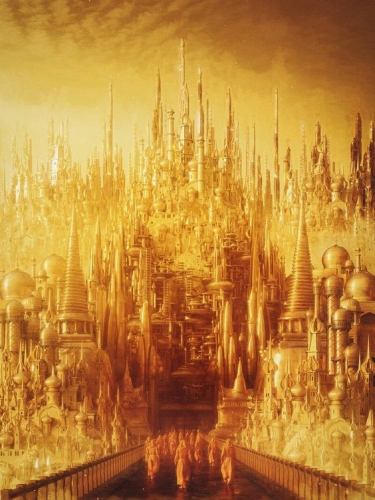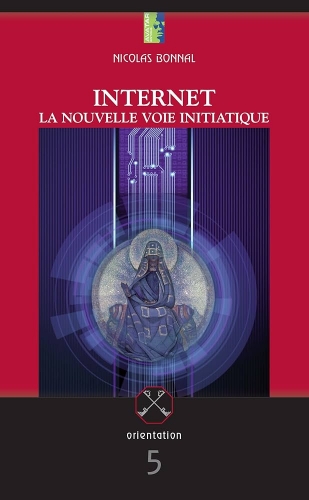
Je reviendrai plus loin sur la récupération tendancieuse de l’astrologie par le New Age, dont il est évidemment possible de trouver des signes avant-coureurs antérieurs à 1960. Je pense tout particulièrement à Paul Le Cour, aussi fondateur de la revue Atlantis en 1926, originaire de Blois comme René Guénon (celui-ci meurt en 1951 et Le Cour en 1954). L’admirateur de Guénon que je suis toujours reconnaît bien volontiers la mesquinerie de certains procès guénoniens dans le cadre de la féroce rivalité qui oppose les deux penseurs issus de la même ville et s’intéressant aux mêmes centres d’intérêt (l’ésotérisme, l’occultisme, l’Atlantide, etc.).
En 1983, le mouvement New Age organise à Bruxelles un grand congrès intitulé « The World We Choose (Le Monde que nous choisissons) ». Une revue est lancée et son titre est révélateur : Réseaux. C’est en effet toute une organisation réticulaire qui s’installe sur le haut de la ville, les beaux quartiers de la capitale de la Belgique et de l’Union européenne. On voit se tisser une immense toile d’araignée dont les fils relient les officines de médecines alternatives (réflexologie, iridologie, radiesthésie), des magasins végétariens, des restaurants macrobiotiques, des écoles de yoga, des centres d’études de thérapies orientales (ayurvédisme, acupuncture), des librairies dont les vitrines et les rayons regorgent d’ouvrages consacrés à la théosophie, l’anthroposophie, les pédagogies non directives.
Le leitmotiv de ce mouvement est la « croissance personnelle ». Le New Age véhicule un individualisme intégral qui, pour reprendre les termes de Julius Evola, constitue son véritable « visage » dissimulé par le « masque » d’un spiritualisme frelaté. Nous avons ici affaire à une forme particulièrement pernicieuse d’égalitarisme qui consiste à attribuer à tout un chacun la possibilité de réaliser sa « croissance personnelle » et les atouts nécessaires à la poursuite victorieuse du bonheur. C’est l’illusion de l’« égalité des chances » qui incite chaque individu à se lancer dans une course effrénée au bien-être et qui suscite in fine des inégalités de plus en plus monstrueuses telles qu’on les voit se développer depuis quelques décennies, après la parenthèse des « Trente Glorieuses » où beaucoup se sont imaginés qu’abattre les fascismes ouvrait automatiquement la voie à une ère d’équité et à la concrétisation du rêve kantien de « paix perpétuelle ».
Lors d’une émission télévisuelle animée par Christophe Dechavanne, un adepte du « Nouvel Âge » affirmait qu’on allait passer d’un cycle caractérisé par l’« amour du pouvoir » à une ère auréolée du « pouvoir de l’amour ». Par-delà le tonnerre d’applaudissements qui salua ces belles paroles (les media utilisent la « claque » comme dans les théâtres d’autrefois), il convient de détecter derrière cette creuse phraséologie une de ces « idées chrétiennes devenues folles, comme dit Chesterton : la confusion entre l’amour communautariste du prochain (réservé aux membres de la communauté des chrétiens) et l’amour laïcisé et universalisé du semblable (dont on doit témoigner envers chaque homme en ce qu’il a d’ordinaire en commun avec les autres, dans la « nudité de son visage », comme l’écrit Levinas).

Matthieu Ricard.
Le New Age se réfère souvent au bouddhisme. Il ne s’agit évidemment pas de la « doctrine de l’Éveil » brillamment analysée par Evola, mais d’une variante édulcorée se présentant sous la forme d’une éthique compassionnelle et altruiste, dans la ligne actuelle du moine Matthieu Ricard, fils de Jean-François Revel. Pour l’homme occidental déchristianisé, le bouddhisme peut servir de philosophie de rechange apte à lui donner un semblant de religiosité tout en faisant l’économie de la transcendance.
Rappelons les réticences de René Guénon vis-à-vis du bouddhisme, qu’il a longtemps perçu comme un moment de « révolte des ksatriyas ». Ananda Kentish Coomaraswamy et Marco Pallis ont dû déployer des trésors de persuasion pour que Guénon, seulement quatre ans avant son décès, admette le caractère « traditionnel » du bouddhisme, en dépit de sa négation du système des castes.
Je m’accorde une brève digression pour suggérer que la « révolte des ksatriyas » ne se réduit pas à une série d’insurrections des « guerriers » contre les « prêtres » (comme dans la querelle médiévale du sacerdoce et de l’Empire), mais constitue un processus plurimillénaire continu analogue au Ragnarokir de la mythologie nordique, l’obscurcissement du divin dans la conscience humaine, le « crépuscule des dieux », comme on le dit souvent et improprement. Ce processus d’obscuration est déjà en germe durant l’« Âge d’Or », ainsi qu’en témoigne le mythe de la chasseresse Atalante poursuivant le sanglier de Calydon. Le sanglier est en effet un des avatars de Vishnou durant l’Âge d’Or. En toute rigueur métaphysique, on peut même dire que ce processus est en germe dès que l’on passe du plan principiel (archè) à celui de la manifestation (genesis), pour reprendre les termes de la Bible des Septante (traduction grecque de l’Ancien Testament). Le choix du mot genesis de préférence au mot poesis montre qu’il ne s’agit pas, à proprement parler, d’une « création », mais d’une « manifestation » qui se développe à partir d’un plan principiel. Il est par ailleurs évident que la caste est, dans le monde pré-moderne, la manière privilégiée d’assigner un cadre limitatif à l’épanouissement individuel, qui se réalise ainsi sub conditione, et non de la manière frénétique et sans limites préconisée par le New Age post-moderne.
J’ai mentionné plus haut l’utilisation de la phytothérapie hindoue et de la médecine traditionnelle chinoise, non pour glorifier le savoir des Anciens, mais pour contribuer à la « croissance personnelle ». Plus importante encore est la récupération de l’astrologie dite « mondiale » (1) pour faire croire que l’humanité passe actuellement d’une « Ère des Poissons » à une « Ère du Verseau », d’un cycle bimillénaire dont l’épicentre a été la Chrétienté médiévale (où l’agapé christique dérive en un « amour du pouvoir ») à une période de durée analogue dont les signes annonciateurs recoupent les symptômes d’une « déconstruction » (censée nous mener au « pouvoir de l’amour »).
Le lecteur peu familiarisé avec l’astrologie sera surpris de voir le Verseau succéder aux Poissons, alors que dans le Zodiaque des saisons, les Poissons viennent après le Verseau. Mais le mouvement pris en considération par le New Age est le déplacement rétrograde du point vernal (du latin ver, vernis, le printemps) dans le Zodiaque sidéral. Ce sont les constellations qu’envisage le New Age, et non les signes énumérés dans les media par les « horoscopes » (terme impropre par ailleurs).

Le point vernal se meut lentement (à raison de 72 ans par degré zodiacal) des Poissons en direction du Verseau, mais comme les frontières des constellations sont floues, on peut diviser le Zodiaque sidéral en douze parties de différentes façons et accréditer la thèse selon laquelle l’« Ère du Verseau » commence aujourd’hui ou aurait débuté au « siècle des Lumières », voire à la Renaissance. L’« Ère du Verseau » coïncide selon certains avec la modernité et pour le New Age avec la post-modernité porteuse d’un « nouveau paradigme ». Les astrologues sérieux, notamment ceux qui éditent les Raphael’s Ephemeridis, prennent pour modèle un Zodiaque sidéral logiquement axé sur les étoiles Aldébaran et Antarès, qui se font face au milieu des constellations du Taureau et du Scorpion. Une fois ce modèle adopté, on constate que le point vernal a encore six degrés à parcourir dans les Poissons et que l’« Ère du Verseau », si tant est qu’elle ait une signification, commence dans un peu plus de quatre cents ans.
Le véritable objectif du New Age est de faire passer les transformations mentales, sociétales et technologiques d’aujourd’hui pour les produits d’une fatalité historique et les germes d’un futur universellement radieux. Il s’agit évidemment d’une contrefaçon de la « fonction prophétique » telle que l’ont exposée René Guénon et Frithjof Schuon, dans le sillage de Saint-Yves d’Alveydre. Cette fonction prédictive est subordonnée à la parfaite connaissance des influences cosmiques telles que la détient la fonction « souveraine », c’est-à-dire « sacerdotale » et » liée au sacré », comme l’écrit un rédacteur d’Éléments (n° 181, décembre 2019 – janvier 2020).
De cette « fonction prophétique » parfaitement intégrable dans la tripartition fonctionnelle dumézilienne, le « Nouvel Âge » offre une parodie diamétralement opposée à la spiritualité indo-européenne. Celle-ci s’illustre à travers les œuvres de Julius Evola, le « tantrika d’Occident », et de rené Guénon, qui s’est certes installé en terre d’islam pour finir ses jours, mais dont les livres majeurs consacrés aux « formes traditionnelles » abordent les divers courants de l’hindouisme.
La branche chrétienne du New Age évoque souvent le passage d’un Christus Ichtus à un Christus Aquarius. Aquarius est le nom latin de la constellation du Verseau, mais c’est aussi l’un des thèmes les plus importants de la comédie musicale Hair, sorte de manifeste soixante-huitard du « Nouvel Âge ». Rappelons que la version française de Hair est due à Julien Clerc, qui chante aussi La Californie et fait plusieurs fois allusion à cette région (2).

En guise de conclusion, je voudrais attirer l’attention de nos lecteurs sur la manière subtile dont s’insinuent dans les esprits les thématiques du « Nouvel Âge » et de la grande « déconstruction » du demi-siècle écoulé à travers des répertoires qui sont loin d’être qualitativement négligeables. Éric Zemmour a pertinemment observé comment la chanson Les Divorcés de Michel Delpech marque le point de départ de la mode des familles recomposées (thème que l’on retrouve aussi dans le répertoire de Daniel Guichard et de Gérard Lenormand). Il serait intéressant de faire une étude exhaustive de toutes ces chansons dont les couplets et les refrains traversent les générations et s’impriment dans les mémoires en charriant insidieusement quelques thèmes « déconstructeurs » fidèles à la perspective New Age. Même dans l’hypothèse où l’« Ère du Verseau » ne ferait pas l’économie d’une catastrophe, la seule maison « à rester debout » serait celle dont on a « jeté les clefs » et que Maxime Le Forestier imagine teintée de bleu sur fond de ciel californien.
Notes:
1 : André Barbault lui-même admet que son « indice cyclique » a des effets davantage locaux que mondiaux et il reconnaît de surcroît la difficulté de localiser ces effets. Son « indice cyclique » est toutefois un outil intéressant. C’est la somme des écarts de longitude entre les planètes. Plus cette somme est basse, plus la période est difficile. Durant le siècle passé, l’indice cyclique le plus bas se situe en 1982.
2 : « J’entends les motos sauvages,
Qui traversent nos villages,
Venant de Californie,
de Londres ou bien de Paris. » (La Cavalerie)













 del.icio.us
del.icio.us
 Digg
Digg

 As Peter Thiel argues persuasively in
As Peter Thiel argues persuasively in Of course workers who are replaced by machines can’t be allowed to starve. The products of machines have to be consumed by someone. Production can be automated but consumption cannot. It would be an absurdist dystopia if mechanization led to the starvation of workers, so consumption had to be automated as well. One set of robots would produce things, then another set of robots would consume them and add zeroes to the bank balances of a few lonely plutocrats.
Of course workers who are replaced by machines can’t be allowed to starve. The products of machines have to be consumed by someone. Production can be automated but consumption cannot. It would be an absurdist dystopia if mechanization led to the starvation of workers, so consumption had to be automated as well. One set of robots would produce things, then another set of robots would consume them and add zeroes to the bank balances of a few lonely plutocrats.



